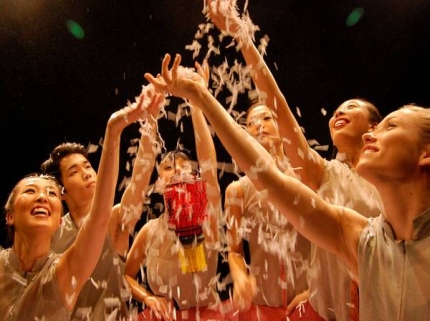 | |
Lantern Festival Performances
Chen Dance Center
70 Mulbery St, New York City
Friday, March 5, 6, and 7, 2015
A Review
Family. Community. Tradition.
On a frigid Friday evening in lower Manhattan I was greeted with the warmth of both the Chen Dance Center and its kind hosts. In an intimate, informal black box theater, Dian Dong greeted the audience with an overview of what this Chinese New Year—the “Year of the Sheep”—held in store. She spoke of the symbolic nature of rice: a celebration of the “sweetness” of a family “sticking together.”
The first piece, entitled Lantern Procession, was a short and vibrant dance of welcoming. HT Chen’s dancers, all technically strong, held a joyous presence on stage, each holding a paper lamp emanating light.
As soon as the first piece concluded Twelve Contra Dances (1980) began. Choreographed by the late Remy Charlip, the duet featured Stephanie Chun and Sean Nederlof, who showed a strong sense of musicality, parallel in tempo and rhythm to the music of Beethoven. While the piece became predictable in floor patterns and repetition, the two dancers maintained a breadth and buoyancy in their execution of the light, pitter-patter-esque footwork. Both clad in white, the imagery was reminiscent of two rabbits frolicking, sometimes playfully, sometimes flirtatiously. The piece maintained a sense of pleasantness and sometimes pomp throughout, most likely inspired by the classical music.
Forget the Past (1986), also choreographed by Remy Charlip, emphasized the back and the fists. Lance Westergard clenched his hands and moved his spine laterally, curving to the right and left in what read as frustration. I yearned to see his face, which I caught only in a glimpse during a turn. The piece ended before I was able to sink into what his backbone and torso were telling us. It was an introspective and quick work.The show closed with three excerpts from South of Gold Mountain, a thoughtful, heavily researched work inspired by the “images and oral histories of the Chinese who settled in the southern states prior to WWII.” The subject matter—fascinating in itself—featured projected historical photos as well as soundscapes of Mississippi: we hear crickets and grasshoppers intermingled with violins as dancers entered the space. Their costumes suggested hard manual labor, as with bent knees they lifted both invisible boxes as well as other dancers. The many bent limbs created a sense of more working bodies on stage than the six dancers. The dance then shifted to a family: mother, father and three children, moving and interacting with one another. This was accompanied by a recorded interview that spoke of the hardship of being a marginalized Chinese citizen in rural Mississippi. The piece closed with bright, colorful costuming, the six movers now in their most energetic and celebratory moments with and for one another. The evening left me with as desire to see the full work at New York Live Arts in fall 2015.
—Megan Mizanty, March 7, 2015